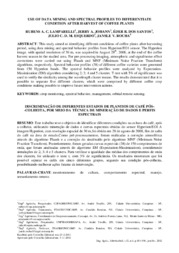Use of data mining and spectral profiles to differentiate condition after harvest of coffee plants.
Use of data mining and spectral profiles to differentiate condition after harvest of coffee plants.
Author(s): LAMPARELLI, R. A. C.; JOHANN, J. A.; SANTOS, É. R. dos; ESQUERDO, J. C. D. M.; ROCHA, J. V.
Summary: This study aimed at identifying different conditions of coffee plants after harvesting period, using data mining and spectral behavior profiles from Hyperion/EO1 sensor. The Hyperion image, with spatial resolution of 30 m, was acquired in August 28th, 2008, at the end of the coffee harvest season in the studied area. For pre-processing imaging, atmospheric and signal/noise effect corrections were carried out using Flaash and MNF (Minimum Noise Fraction Transform) algorithms, respectively. Spectral behavior profiles (38) of different coffee varieties were generated from 150 Hyperion bands. The spectral behavior profiles were analyzed by Expectation-Maximization (EM) algorithm considering 2; 3; 4 and 5 clusters. T-test with 5% of significance was used to verify the similarity among the wavelength cluster means. The results demonstrated that it is possible to separate five different clusters, which were comprised by different coffee crop conditions making possible to improve future intervention actions.
Publication year: 2012
Types of publication: Journal article
Observation
Some of Embrapa's publications are published as ePub files. To read them, use or download one of the following free software options to your computer or mobile device. Android: Google Play Books; IOS: iBooks; Windows and Linux: Calibre.
Access other publications
Access the Agricultural Research Database (BDPA) to consult Embrapa's full library collection and records.
Visit Embrapa Bookstore to purchase books and other publications sold by Embrapa.

